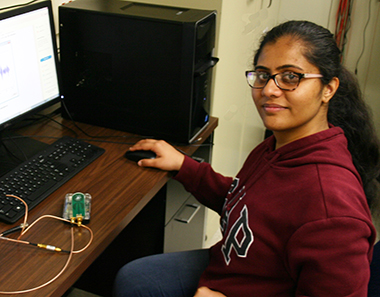Keeping on Schedule
 |
|
Priti Pachpande, a PhD candidate in computer science at CEAS, works on the ultra-wideband technology project at CTG. |
ALBANY, N.Y. (April 21, 2017) — As you ride UAlbany’s transportation this semester, you are actually helping a UAlbany research team determine the effectiveness of a new radio technology being considered by cities worldwide as they invest in the Internet of Things (IoT).
A research team from the Center for Technology in Government (CTG) and the Signals & Networks Lab (SINE) in the College of Engineering & Applied Sciences is working with Parking and Mass Transit and the Office of Facilities Management to study the feasibility of using ultra-wideband (UWB) technology, a wireless radio system that uses a small amount of energy to transmit large amounts of data over a wide range of frequency bandwidths to allow for ranging and localization at the same time.
UWB technology, one of several types of technologies that can power the IoT, can be applied to smart streetlights that dim at certain hours or sensors in parking garages that allow citizens to find available parking with the help of a smartphone app. UWB can also be used in public transportation, with potential benefits including:
- Better tracking of trains and buses to help with scheduling that alleviates delays
- Improving the fare payment process by eliminating the need for turnstiles, tickets or cards (such as by sensing your public transportation card in your pocket)
- Detecting potential obstacles in front of a train or bus to improve safety
However, while these benefits sound promising, it is not clear if UWB can actually meet the demands placed on it within the context of a live public transportation infrastructure. To help build new understanding of what is really possible, the team, including PhD students Priti Pachpande and Ahmed Hussein, is investigating three key questions:
- Will the UWB technology integrate well into the existing technology systems used in the city?
- How accurate is the UWB technology — for example, can it detect the buses’ location within 10-cm accuracy?
- Is UWB consistent and resilient?
“The uses of the IoT across industries and sectors are increasing, and governments are taking notice and beginning to explore how they and their citizens might benefit,” says Derek Werthmuller, director of Technology Innovations & Services at CTG.
“While governments are looking at the benefit side of the equation, they also need new information to guide investment decisions, in particular identifying which factors must be considered when choosing IoT technologies and UWB strategies. This study will generate new understanding about how practical UWB is in a variety of uses, and will provide decision-making guidance for governments around the world.”
Hany Elgala, assistant professor of Electrical & Computer Engineering in CEAS and director of the SINE lab, said, “this project is helping us better understand the propagation characteristics of the signals the UWB technology transmits, and it’s also helping to assess and improve the performance of UWB-based technology. I'm pleased to be part of such an exciting project making major steps towards a solution that could accurately, reliably and securely position an object in a 3D space.”
The eight-month study led by CTG will assess the effectiveness of UWB through a series of experiments in UAlbany’s transportation infrastructure on the Uptown Campus, including the tunnel system. Select buses and shuttle stops will be equipped with sensors that are transmitting data to the team using UWB anchors.
The findings from this data-gathering and analysis will help governments answer their questions about UWB’s accuracy, consistency, resiliency and ability to effectively integrate with other the technology systems the governments are already using. As with any technology investment, IoT investments are not “one size fits all” and therefore many variables must be considered prior to purchasing a new system.
![]() For more news, subscribe to UAlbany's RSS headline feeds
For more news, subscribe to UAlbany's RSS headline feeds
A comprehensive public research university, the University at Albany-SUNY offers more than 120 undergraduate majors and minors and 125 master's, doctoral and graduate certificate programs. UAlbany is a leader among all New York State colleges and universities in such diverse fields as atmospheric and environmental sciences, business, education, public health,health sciences, criminal justice, emergency preparedness, engineering and applied sciences, informatics, public administration, social welfare and sociology, taught by an extensive roster of faculty experts. It also offers expanded academic and research opportunities for students through an affiliation with Albany Law School. With a curriculum enhanced by 600 study-abroad opportunities, UAlbany launches great careers.


